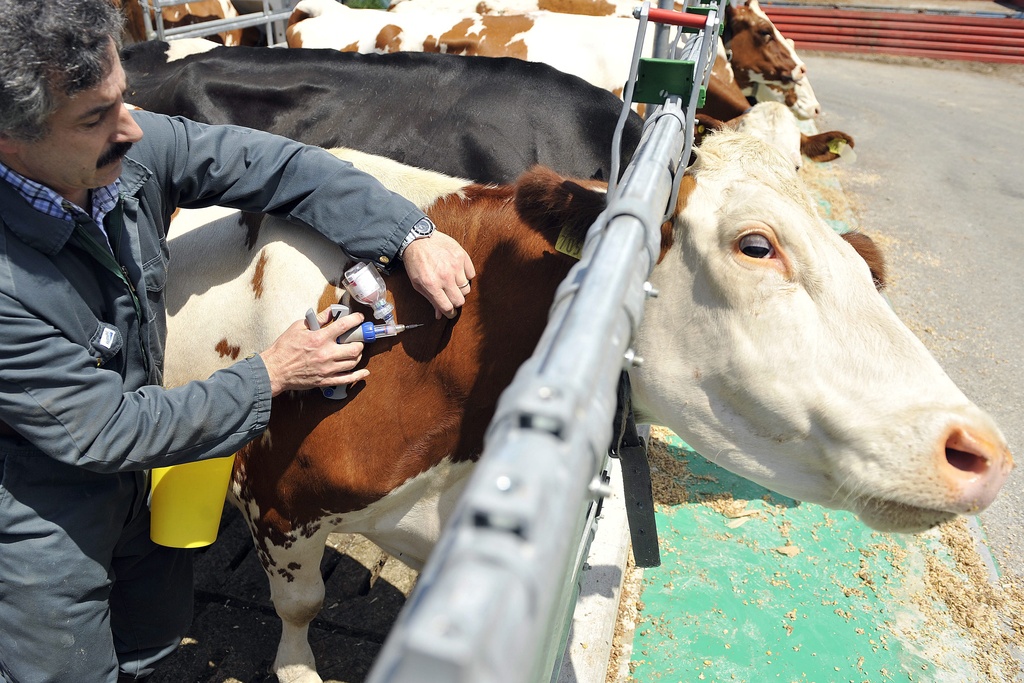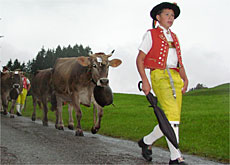Swiss tackle the threat of animal diseases

BSE, bird flu, foot and mouth, bluetongue, swine flu – it’s been an active decade for animal diseases and Swiss authorities are now preparing for the next wave.
As veterinary experts know, it’s not a question of if the next big disease outbreak happens but when, something that the new Swiss animal health strategy aims to address.
Although Switzerland is widely regarded as a best practice example in the area of animal health, global developments make vigilance essential.
On Tuesday the Federal Veterinary Office presented its strategy for 2010 to 2020 in Bern to farming, veterinary and food industry representatives. The five-point plan, with a focus on prevention, was well received by delegates.
Addressing the conference, the director general of the World Organisation for Animal Health, Bernard Vallat, stressed the intrinsic link between animal health and human health.
“Sixty per cent of human pathogens [disease causing agents] are of animal origin,” he pointed out. Recent experience with the H1N1 outbreak remains fresh in the public’s memory.
Early detection
“Increased surveillance is necessary to quickly detect any new event, to implement a rapid response and to block the pathogen where it appears,” Vallat said.
The Federal Veterinary Office strategy, developed in conjunction with the cantonal authorities, includes improved disease testing at all stages from farm to food plant.
Vallat told swissinfo.ch that known pathogens from tropical countries were likely to spread northwards.
“The vectors [carriers] of these pathogens are more and more able to survive the winter in non-tropical countries. So we can say that diseases such as Rift Valley fever, existing in Africa with vectors [in this case mosquitoes] now able to survive the winter in Europe could colonise non-tropical countries and we must be ready for that,” he warned.
African horse sickness, related to bluetongue which has already appeared in Switzerland, is another devastating virus waiting in the wings.
Mutual benefit
This means prevention has to reach beyond the borders of well resourced countries.
“We have to develop support for countries where pathogens still exist and to help the poor countries to improve their veterinary services to control the disease,” Vallat explained.
“It’s a win-win action because it helps alleviation of poverty and public health while at the same time reducing the threat for the country providing the support,” he added.
The Swiss signed an accord on Tuesday with the Paris-based World Organisation for Animal Health agreeing to contribute SFr200,000 per year over the next three years to the global fund for the health and well-being of animals. The money will be used to support veterinary services in developing and emerging economies.
Testing, testing
As part of national strategy preparation measures, the Swiss authorities will carry out a simulation exercise in 2011 testing the response to an outbreak of a highly contagious animal disease.
Swiss farmers who lost livestock in the 2008 bluetongue outbreak were compensated to the tune of 90 per cent of the value of the animals destroyed.
“We are in a strong position but we really have to be prepared for the future, for climate change, for increased trade and movement of animals and people,” Veterinary Office spokesman Marcel Falk told swissinfo.ch.
Vallat used a military metaphor to describe the work being done to combat animal disease, commending vets for their front line role.
“A good working relationship between vets and farmers is the key to the success of good governance,” he said.
When the discussion was opened to the floor, representatives of the Swiss Farmers Association welcomed the new strategy while the president of the Society of Swiss Veterinarians, Charles Trolliet, pleaded for vets not to be seen as a cost or impediment to farming but as a contributing part of the process.
Clare O’Dea, swissinfo.ch
Prevention, improving early testing
Preparation for crisis situations, including national epidemic simulation exercise in 2011
Fight against significant epizootic and animal diseases from economic standpoint
International collaboration
Building scientific knowledge, research and development
60% of human pathogens are of animal origin
75% of emerging diseases come from animals
80% of the agents which could have a bioterrorism use are animal pathogens

In compliance with the JTI standards
More: SWI swissinfo.ch certified by the Journalism Trust Initiative






You can find an overview of ongoing debates with our journalists here . Please join us!
If you want to start a conversation about a topic raised in this article or want to report factual errors, email us at english@swissinfo.ch.